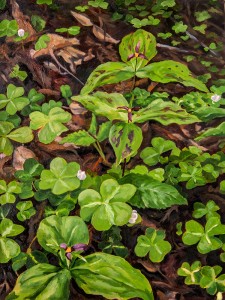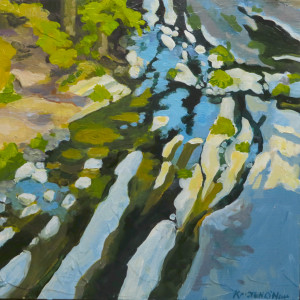The re-post below is from my sister-in-law, painter Kristen O’Neill. She is a fantastic contemporary landscape painter who paints portraits of places in nature. She finds the essence of those spaces and lets you into that world. I’m so lucky to have her paintings in my house and her skilled eye to critique me when I’ve lost my artistic way. The post below is her answer to the question every artist has heard at an exhibit, “How long did it take to make that?” I’ve thought about writing my own answer to this question but I really couldn’t say it any better…
By the way, you can commission or buy a painting from her here: Kristen O’ Neill Art Enjoy!
How long did it take to paint that?
The most common question I hear at a gallery opening or a festival show is “how long did it take you to paint that?”
It is a fair question. It is also an easy and safe question. People ask this when they are interested in my work and my process. They may possibly be asking in relation to my price (is it really worth $800?).
I want to have an answer for you. But I don’t. Not because I haven’t tracked my hours spent at my easel (because I have). Not because I lost track of how many hours went to that particular painting (I may have, but could rough out an answer because I know my process). The truth lies in the fact that the question is too small for my answer.
Let’s pretend I spent 20 hours on it, in front of the easel time. That is probably the answer I should give, but it is an incomplete answer.
I spent 5 minutes mixing the gray for the rock.
I spent 15 minutes mixing an EXACT copy of that color when I realized I wanted to change the way the edge of that color interacted the next day and no longer had the color mixed on palette.
I spent 20 minutes on clean up (brush cleaning, palette scraping, general clean up tasks) every time I was interrupted for more than a few minutes, or at the end of each painting session. Or when the baby decided she really wasn’t going to take that nap.
I spent a lot more time just looking at it. There is a great scene in the Netflix show “Grace and Frankie” where Lily Tomlin’s character states that she and her painting “aren’t talking right now.” As I write this I am currently casting sidelong looks at an uncooperative painting. Earlier I was trying the silent treatment. The painting always wins these silent wars. I have kept works in progress in my bedroom. I stare at them as I fall asleep, and when I wake up I am looking again for some sort of answer I swear it must have in it. Often I find my answer. Sometimes I find that my answer is that I have a critical error and must start again.

My favorite painting is one that I hang in my bedroom in and find no areas that I want to fix.
But if we put what I’ll call “skill development” aside there is still research and inspiration. I am currently working on a series centered around the beautiful Umpqua National Forest. It takes time to drive there, and hike to the spots that I am painting. I took over 850 photos on my last hike. It would have been more, but I ran my battery completely down from a full charge. Sometimes when I take a photo I know I will be painting that scene. Something feels right. Sometimes I spend a couple of hours pouring over the images figuring out which are the closest that show what I felt from the place.I have painted since my first watercolor set in preschool. But lets discount the first 15 years of painting and go with college level and beyond. When I make a painting now, it isn’t a stand alone moment. It is years of practice and learning and experimentation poured into it. It is a slow development of techniques. Hours of practice mixed with hours of research. Hours of time spent in museums, galleries, festivals and fairs looking at art.
More then once I have had to return to the very spot to solve a problem. What does it look like with more sunlight? Was that a far away tree or a close up branch? What happened in that dark spot there? Often the issue is color. The camera decisions and my decisions are not the same. It likes to turn the whole world blue when I’m not looking.
So when you ask me how long it took, I’ll say 20 hours. But feel free to ask me more because that isn’t the real answer.

“Little River at Wolf Creek Trailhead” is an example of my Umpqua National Forest series.
In this painting you can see the smooth yet contoured river bed rocks that are normally under several feet of water. During the drought they became visible and made these interesting and graphic patterns. It was fun to explore them with painterly brushstrokes. I also loved the way the late afternoon sun broke apart as it fell across them. Like it was hopping across the river rock.
This painting is available for sale here and took 5 hours to paint, a 3 hour hike, and 3 hours in the car round trip, not including bathroom breaks for the kids.